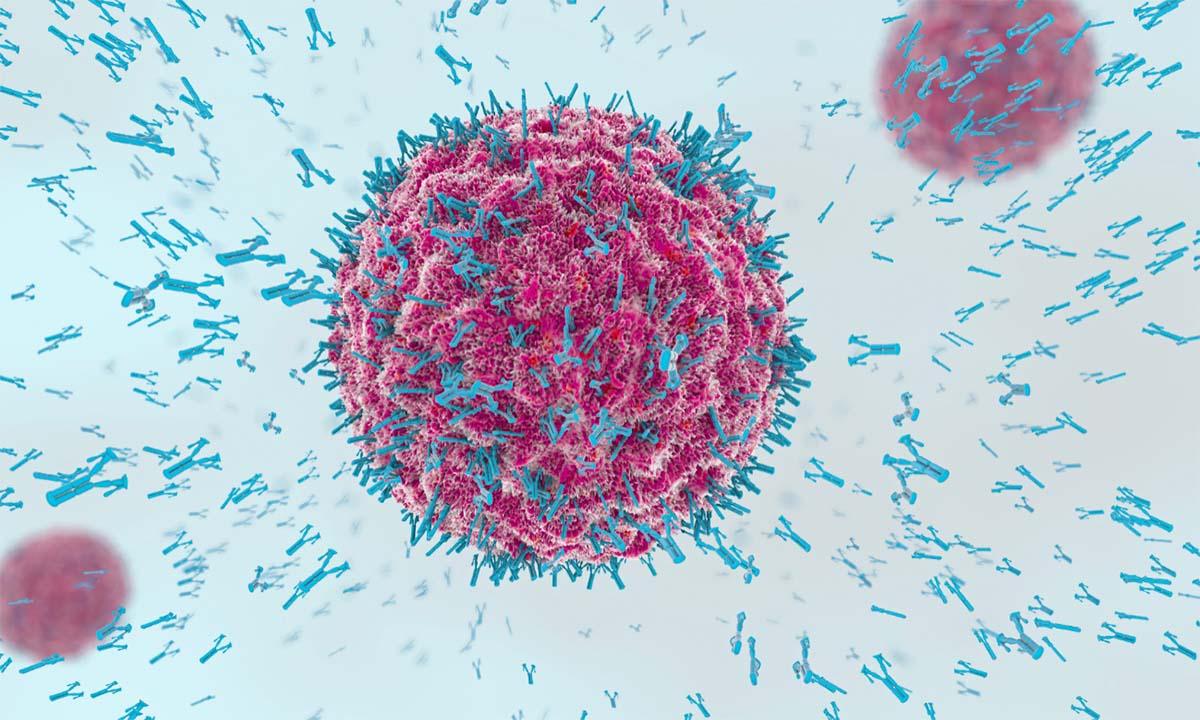It is no wonder that Glutathione (GSH) earns such wonderous titles as 'master detoxifier', the 'mother of all antioxidants, and 'maestro of the immune system'. In the words of Gustavo Bounous, MD, a past professor of surgery at McGill University in Montreal, "It's the body's most important antioxidant because it's within the cell" (a-3). Because Glutathione exists within the cells, it is in a prime position to support our immunity.
Glutathione is well known to play a direct role in your body's ability to directly fight off disease caused by free radicals (toxins). Lesser known is its ability to enhance white blood cell count activity and coordinate a defensive attack against infection-causing bacteria or viruses.
This blog post will discuss Glutathione and its role in boosting your immune response, focusing on its T-Cell function and what you can do to optimise its production.
Image above: Illustration of antibodies attacking a pathogen
An Immune Response to an outside invader
The immune system is our body's first line of defence from outside invaders, such as bacteria, viruses, and toxins (chemicals produced by microbes).
The immune system comprises different organs, cells, and proteins that fight infection (microbes). The main parts of the immune system are white blood cells, antibodies, the complement system, the lymphatic system, the spleen, the thymus, and the bone marrow. These all actively fight infection.
White blood cells are the immune systems leading defensive players moving throughout your body via the blood and tissue, looking for foreign invaders. When they find them, they launch an immune attack.
Produced in your bone marrow and part of the lymphatic system, White Blood Cells include lymphocytes (such as B-cells, T-cells and Natural Killer Cells) and many other types of immune cells.
There are, in fact, two main parts to the immune system:
- The innate immune system, which you are born with, patrols the body and is the first to respond when locating an intruder. This inherited system is active and primed to find, surround, and engulf the invader from the moment we are born. The invader is killed inside the immune system cells, called phagocytes.
- The adaptive immune system, which you develop over time. When your body is exposed to invaders (pathogens & antigens), which slip through the innate system, it uses T-cells and B-cells (Lymphocytes) to deal with the intrusion. While both are critical to the body's defence against disease and infection, T-cells and B-cells play very different roles.
What is a Pathogen?
Pathogen's - Pathogen is a fancy science word for germ, invisible to the naked eye. Any microorganism which can cause illness in a host organism is termed a pathogen. They include the usual bacteria and viruses, fungus and other microorganisms. The common cold, influenza, chickenpox and corona are all pathogen viruses.
Viruses can live for a surprisingly short or long time depending on the type and conditions, such as moisture and temperature. A cold virus within body fluids left on a kitchen surface via hands or a sneeze or cough can survive for several days. However, its ability to cause infection drops dramatically over time. Flu viruses can survive in the air for several hours and up to twenty-four hours on the surface. Viruses tend to live longer on water-resistant surfaces, such as stainless steel and plastics. Unless a live host comes along, they will eventually die. While not technically alive, viruses will not survive for long unless they find a host cell within a person, animal, or plant to live in.
Bacteria on the other hand, such as strep throat, is a sickness caused by Salmonella and Streptococcus bacteria are alive as a single cell organism, which can live on its own.
Antigens are a molecular pattern found on the surface of pathogens, toxins, chemicals, and pollens (made of proteins, polysaccharides, lipids or nucleic acids). For each specific pathogen and disease it causes, the Antigen pattern is unique. The more scientific terminology is 'science pathogen-associated molecular patterns (PAMPs). Antigens give the immune system a warning sign that a new foreign microbe has been found in the body and must deal with the potential threat.
Components of an antigen called epitopes are the regions where the antigen and the antibody connect on the pathogenic cell, a bit like a space docking station.

Image above: Illustration design of antibodies
B-Cell's and their Antibodies
B Cells (B lymphocytes) are white blood cells that produce antibodies to fight invader microbes or toxins (pathogens) after exposure to an antigen. Invading microbes are produced from internal or external sources, i.e. the air we breathe, food we eat, or internal stress on the body.
Antibodies contain a paratope, a small region at the antibody's tip that binds to the antigen epitope with high affinity. This binding mechanism, a bit like a lock (epitope) and key (paratope), or two puzzle pieces with the same unique pattern, enables them to interlock together. This process allows for the antibody B-cells to track the pathogen and prepare for a defence.
B-cells are each programmed to make only one specific antibody which can take up to several days to develop. For this reason, we can sometimes feel ill for several days as the army of antibodies builds. Humans generate billions, if not trillions of different antibodies over a lifetime, each capable of binding to a distinct epitope (the docking station) of an antigen.
The antibody recruits other defensive molecules and immune cells, like T-cells in the bloodstream, to make their way to the now marked invader. They all work together to neutralise the infection-causing pathogen. Once killed, it is then engulfed and digested by macrophage cells.
Macrophages are specialist, quite large, white blood cells which scavenge the body looking to remove dying or dead foreign bodies (pathogens). The term 'macrophage' is formed from the Greek terms "makro" meaning big, and "phagein" meaning eat.
After the first exposure to a new microbe, the immune system learns and keeps a record of everyone it has ever defeated. If it appears again, it knows to defend against it, this time more swiftly, preventing you from feeling ill.

Image above: T-Cell Immune Response
The Role of T-Cells
T-cells are like the special armed services (SAS), where a strong reaction is needed to deal with a specific foreign antigen for maintaining effective immunity. T-cells use cytokines cells as messenger molecules which aid cell to cell communication for ramping up its response to move cells towards sites of inflammation, infection and trauma.
There are two main T-Cell role types, 'Helper cells', which help activate B cells to produce antibodies. Or they can act as "Natural Killer Cells" (NK), which directly attack and kill cells already infected by a foreign invader (Pathogen).
When T-cells become active, they produce reactive oxygen species (ROS). ROS have positive effects on T-cell signalling and proliferation (growth and multiplication of cells). Low concentration ROS in T-cells is a pre-requisite for cell survival as high ROS accumulation can lead to the dismantling of (apoptosis) and/or cell death (necrosis) through accidental cell inflammation. A delicate balance between ROS and antioxidants (The cellular redox state) is needed for T-cell receptor signalling to launch an effective immune response.

The Glutathione Response
A robust Glutathione antioxidant response is needed to buffer rising ROS and prevent cellular damage. Studies have shown that Glutathione directly affects the T-cell function and Macrophages required for effective T cell activation. It is also needed to stimulate the production and activity of natural killer (NK) cells. Therefore, the protective activity of GSH is two-fold – it enhances the activity of immune cells and functions as an antioxidant within them.
Because Glutathione depletion may occur in sepsis, trauma, and shock, maintaining glutathione levels is essential for enhanced immunocompetence to aid recovery from illness.
In infancy, T-cells are used primarily to develop immunity against more common pathogens or antigens. As learning from their engagement with pathogens builds, 'memory T-cells' are created that remain with you through adulthood. As fewer 'new strain' pathogens and antigens enter the body, T-cells aim to balance and regulate the immunology for repeat or chronically encountered foreign invaders. Plus, they bring some focus to surveillance for tumours during this stage in life.
Glutathione (GSH) is a small protein molecule composed of three amino acids: cysteine, glutamate, and glycine. Foods such as broccoli, garlic, strawberries, spinach and kale contain GSH. However, it is not so easily absorbed by the body, which means we need to find alternative ways to increase its levels. If you are looking for an efficient way to increase your Glutathione intake, consider liposomal supplements using Reduced-L Glutathione over tablet or capsule forms, which by comparison are not as easily absorbed. Glutathione recyclers such as Selenium & Vitamin B6 are also beneficial
Liposomes are microspheres (bubbles) suspended in a liquid, which encapsulate the Glutathione and help higher amounts of it absorb into the body and be more easily transported to where it is needed most. It is recommended that 500mg a day should be taken in supplement form. Higher amounts of 1000 - 2000mg a day can be taken if not well.






